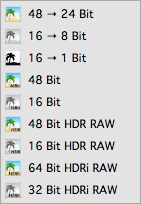48 -> 24 Bit General Color Images
This creates the usual 24 bit color images. 24 bit is the most commonly used color depth for most applications. When you do not know which output you should use this is most likely the right one. 24 bit data can be saved into small JPEG files.
16 -> 8 Bit General Grayscale Images
This creates 8 bit grayscale images. 8 bit is the most commonly used grayscale depth for most applications. When you do not know which output you should use for grayscale images, this is most likely the right one. 8 bit data can be saved into small JPEG files.
16 -> 1 Bit Line Art Images
This creates 1 bit images which only consists of absolute black and white values. This for example can be used for scanning text.
48 Bit High Dynamic Range Color Images
48 bit color images are best for further editing in professional software like SilverFast HDR (Studio) or Photoshop. They can be saved in TIFF or JPG2000. Simple JPEG files can not store 48 bit data (see 48 -> 24 bit).
16 Bit High Dynamic Range Grayscale Images
16 bit grayscale images are best for further editing in professional software like SilverFast HDR (Studio) or Photoshop.
They can be saved in TIFF or JPG2000.
Simple JPEG files can not store 16 bit data (see 16 -> 8 bit).
48 Bit HDRRAW High Dynamic Range Archive for Color Images
This creates 48 bit raw color archive images. These are saved unaltered and are optimized for processing in SilverFast HDR (Studio). This format does not save the infrared channel.
16 Bit HDRRAW High Dynamic Range Archive for Grayscale Images
This creates 16 bit raw grayscale archive images. These are saved unaltered and are optimized for processing in SilverFast HDR (Studio). This format does not save the infrared channel. This is the most common Archive Suite format for grayscale silver halide film.
64 Bit HDRiRAW High Dynamic Range Archive for Color Images with Infrared Channel
This creates 64 bit raw color archive images. These are saved unaltered and are optimized for processing in SilverFast HDR (Studio). This format does save the infrared channel for iSRD processing. This is the most common format for images used in the Archive Suite workflow.
32 Bit HDRiRAW High Dynamic Range Archive for Grayscale Images with Infrared Channel
This creates 32 bit raw grayscale archive images. These are saved unaltered and are optimized for processing in SilverFast HDR (Studio). This format does save the infrared channel. This is the most common Archive Suite format for grayscale film processed using the C41 standard (like color film).
xx Bit HDR(i)RAW advanced High Dynamic Range Archive format
|
The HDR(i) RAW files can be considered as a kind of "RAW format from analog data". In addition to the image data, color management information is included, where applicable also infrared data for dust and scratch removal and Negafix profiles for negatives. Optimized images are exported as TIFF or DNG files, while retaining the original image data. Following this way, various image optimizations can be made from the same starting point for comparison.
HDR(i) RAW files store all changes and settings inside the image file. While normal HDR(i) files store their changes in a local database. This function is optional and can be selected in the SilverFast preferences' general tab.
|
|








